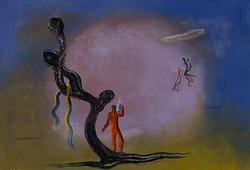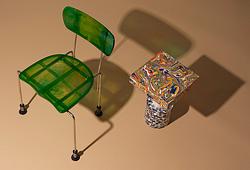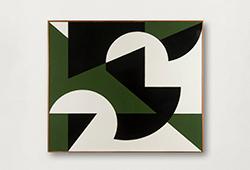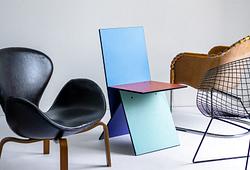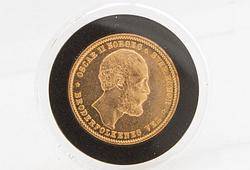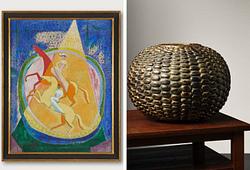Bukowskis and Marimekko in dialogue with Astrid Sylwan
Bukowskis & Marimekko
The Artists Who Shaped Us Astrid Sylwan
Considering she’s one of Sweden’s most celebrated abstract painters, it’s hard to fathom that Astrid Sylwan applied ten times before getting accepted into Konstfack’s Master of Fine Arts programme at the age of 29. But as her prominent career has later shown, Sylwan’s impressive perseverance clearly paid off in full with countless accolades and recognitions to her name.
Selected for Marimekko’s special anniversary auction, “The Artists Who Shaped Us”, we caught up with Sylwan for a conversation about her working relationship with the Finnish design house. We also asked what it’s like for a painter to go from the originality of a canvas to repeated prints on cushions, curtains, and clothes.
Being such an integrated part of Nordic design history, many people across the Nordic countries have personal relationships or memories of Marimekko. Does that go for you as well?
– My first memory of Marimekko was my childhood’s bedroom, where my mum made me curtains out of the Unikko textile in blue, yellow and orange. The room was bright yellow. In my memory, the sun was always shining through those curtains. I loved that room.

How did your collaboration with Marimekko come about?
– I was sat on a train travelling through Sweden when Minna Kemell-Kutvonen, design and product development director at Marimekko, called me. When she introduced herself, my immediate thought was, “please ask me for a collaboration” It had never crossed my mind before, but I instantly felt it would be a perfect match.
As a painter, how did it feel to be working with textiles?
–I have always been drawn to strong colours and patterns. My artistic practice is a bit different from design practice. I wanted to bring some of the poetry of the art into the fabric. My paintings always carry a story. Often subtle, like a state of mind, a feeling or an emotion. The painting leads me where it wants to go in the moment. Like a conversation between me and the canvas. Over the years, I look at them as a diary of my thoughts and states of mind.
A textile is quite different. It shapeshifts into cushions, curtains, clothes or whatever the consumer wants. There is also the aspect that it is not an original; it’s printed in thousands of meters.
I strongly believe in the magic of the hand and in the uniqueness of a painting. It was a challenge to let go of that thought and to make a print that held the quality of a painting through the industrial process of printing.

Astrid Sylwan, 'Irrbloss'. Sign. Förlaga (original) Marimekko 2010. Oil on canvas 95 x 90 cm.
How did you experience your collaboration with Marimekko’s printmakers?
– I couldn’t have done it without them. I have no training in textiles, and though they did their best to educate me, the challenge was beyond me. The genius printmaker Petri Juslin sent me an email when he had finished the prints that said: “Working with you is like jumping out of an aeroplane without a parachute.” The feeling was mutual for sure.
Did anything surprise you about the collaboration?
– Yes, how difficult it was. I didn’t know what to expect, but I didn’t expect it would take a year and a bit. I learned a lot in the process.
Can you tell us about the inspiration behind the Vattenblänk pattern?
– It came to me at my first visit to Marimekko’s factory in Helsinki. I saw the big, long printmaking tables where the fabrics flow like a stream while being printed. That gave me the idea to make it into a stream, where the water swirls around the rocks and stones, and the trees, the sky and the light reflects in the water. I wish I could have seen it printed. I never did.
You and Marimekko received the Elle Interiors Design Award for Fabric in 2012. How did it feel to suddenly be recognized in a design rather than an art category?
– That was a huge surprise and one that I am awfully proud of. It is all part of my artistic practice. The labels are superficial.

Astrid Sylwan, 'Irrbloss'. Sign. Förlaga (original) Marimekko 2010. Oil on canvas 95 x 90 cm.
Story has it you really challenged the printmakers with the Vattenblänk pattern. Can you tell us why it was so difficult to make?
– That was by far our most difficult of the prints as it had to report endlessly in a constant flow. That meant every millimetre must seamlessly fit into the next without losing the energy of the painting. That’s a difficult task.
Like Marimekko, you are known for your bold colours. Are there particular colours you keep coming back to, or does it change over time?
– It changes over time. Slight shifts over the years, although I do tend to always use a quite intense pallet. I think it’s in the blood. Like a singer is a baryton, tenor, bass or a soprano, a painter also has a tone. Mine is energetic.
Would you like to tell us about the pieces you selected for this auction?
– They are, in fact, the paintings that the Marimekko patterns “Vattenblänk” and “Irrbloss” are based on.
What’s the next big thing you’re working on?
– After a long pause during covid I have an intense year ahead of me with solo shows at Teatergrillen in Stockholm, Flamenska galleriet in Borås, Bror Hjorts museum in Uppsala and Galleri Örsta in Örebro and group shows at Eskilstuna art museum and at Kunst im Westend Berlin.
To the anniversary auction
Browse and bid

Estimate
600 EUR

Estimate
2 000 EUR

Estimate
200 EUR

Estimate
800 EUR

Estimate
1 800 EUR

Estimate
400 EUR

Estimate
5 000 EUR

Estimate
300 EUR

Estimate
1 500 EUR

Estimate
1 400 EUR





